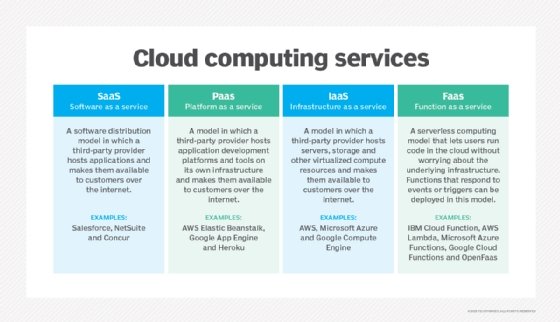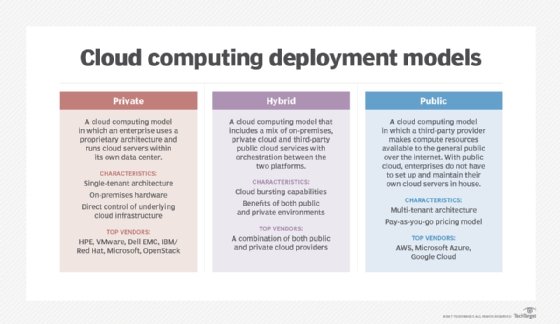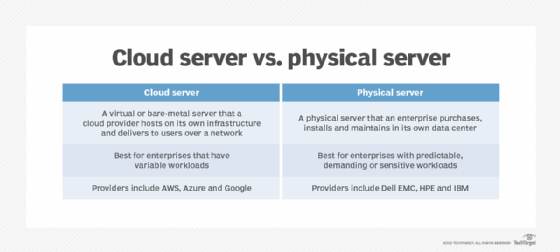
cloud server
A cloud server is a compute server that has been virtualized, making its resources accessible to users remotely over a network. Cloud-based servers are intended to provide the same functions, support the same operating systems (OSes) and applications, and offer similar performance characteristics as traditional physical (and virtual) servers that run in a local data center. Cloud servers are often referred to as virtual servers, virtual private servers or virtual platforms.
Cloud servers are an important part of cloud technology. Widespread adoption of server virtualization has largely contributed to the rise and continued growth of utility-style cloud computing. Cloud servers power every type of cloud computing deployment model, from infrastructure as a service (IaaS) to platform as a service (PaaS) and software as a service (SaaS).
How do cloud servers work?
Cloud servers work by virtualizing physical servers to make them accessible to users from remote locations. Server virtualization is often, but not always, done through the use of a hypervisor. The compute resources of the physical servers are then used to create and power virtual servers, which are also known as cloud servers. These virtual servers can then be accessed by organizations through a working internet connection from any physical location. Cloud servers are provisioned and managed through cloud-based APIs.

In a public cloud computing model, cloud vendors provide access to these virtual servers, storage and other resources or services in exchange for fees that are typically structured as a pay as you go (PAYG) subscription model. Cloud deployment models that include only traditional infrastructure elements such as virtual servers, storage and networking are called IaaS. PaaS products provide customers a cloud computing environment with software and hardware tools for application development, which are powered by cloud servers, storage and networking resources. In the SaaS model, the vendor delivers a complete, fully managed software product to paying customers through the cloud. SaaS applications rely on cloud servers for compute resources.
Although private cloud servers work similarly, these physical servers are part of a company's private, owned infrastructure.
Types of cloud servers
An enterprise can choose from several types of cloud servers. Three primary models include the following:
Public cloud servers. The most common expression of a cloud server is a virtual machine (VM) -- or compute "instance" -- that a public cloud provider hosts on its own infrastructure and delivers to users across the internet using a web-based interface or console. This model is known as IaaS. Public cloud servers typically use prefabricated instances, which assign a known number of virtual CPUs (vCPUs) and memory. Examples of cloud servers include Amazon Elastic Compute Cloud (EC2) instances, Microsoft Azure instances and Google Compute Engine instances.
Private cloud servers. A cloud server can also be a compute instance within an on-premises private cloud. In this case, an enterprise delivers the cloud server to internal users across a local area network (LAN) and, in some cases, also to external users across the internet. The primary difference between a hosted public cloud server and a private cloud server is that the latter exists within an organization's own infrastructure, whereas a public cloud server is owned and operated outside of the organization. Private cloud servers can rely on prefabricated instances, but also enable users to select a desired amount of vCPU and memory resources to power the instance. Hybrid clouds can include public or private cloud servers.
Dedicated cloud servers. In addition to virtual cloud servers, cloud providers can supply physical cloud servers, also known as bare-metal servers, which essentially dedicate a cloud provider's physical server to a user. These dedicated cloud servers -- also called dedicated instances -- are typically used when an organization must deploy a custom virtualization layer or mitigate the performance and security concerns that often accompany a multi-tenant cloud server.

Cloud servers are available in a wide range of compute options, with varying processor and memory resources. This enables an organization to select an instance type that best fits the needs of a specific workload. For example, a smaller Amazon EC2 instance might offer one virtual CPU and 2 GB of memory, while a larger Amazon EC2 instance provides 96 virtual CPUs and 384 GB of memory. In addition, it is possible to find cloud server instances that are tailored to unique workload requirements, such as compute-optimized instances that include more processors relative to the amount of memory, or instances that incorporate graphics processing units (GPUs) for math intensive workloads.
Although it's common for traditional physical servers to include some storage, most public cloud servers do not include storage resources. Instead, cloud providers typically offer storage as a separate cloud service, such as Amazon Simple Storage Service (Amazon S3) and Google cloud storage. An organization provisions and associates storage instances with cloud servers to hold content, such as VM images and application data.
Benefits of cloud servers
The choice to use a cloud server will depend on the needs of the organization and its specific application and workload requirements. Some potential benefits include the following:
Ease of use. An administrator can provision a cloud server and connect other services to that server in a matter of minutes. With a public cloud server, an organization does not need to worry about server installation, maintenance or other tasks that come with owning a physical server.
Globalization. Public cloud servers can globalize workloads. With a traditional centralized data center, admins and users can still access workloads globally, but network latency and disruptions can reduce performance for geographically distant users. By hosting duplicate instances of a workload in different global regions, organizations can benefit from faster and often more reliable network access.
Cost and flexibility. Public cloud servers follow a PAYG model. Compared to a physical server and its maintenance costs, this can save an organization money, particularly for workloads that only need to run temporarily or are used infrequently. Cloud servers are often used for temporary workloads, such as software development and testing, as well as for workloads where resources need to be scaled up or down based on demand. However, depending on the amount of use, the long-term and full-time cost of cloud servers can become more expensive than owning the server outright. Furthermore, a full breakdown of cloud computing expenses is important to avoid hidden costs.

Challenges of cloud servers
The choice to use a cloud server can also pose some potential disadvantages for organizations.
Regulation and governance. Regulatory obligations and corporate governance standards might prohibit organizations from using cloud servers and storing data in certain geographic locations -- often outside of the organization's geographic, political or regulatory boundaries.
Performance. Because cloud servers are typically multi-tenant environments, and an admin has no direct control over those servers' physical location, a VM can be adversely affected by excessive storage or network demands of other cloud servers on the same hardware. This is often referred to as the "noisy neighbor" issue. Dedicated or bare-metal cloud servers can help an organization avoid this problem. In other cases, such problems can be addressed by moving workloads to other resources, availability zones or regions.
Outages and resilience. Cloud servers are subject to periodic and unpredictable service outages, usually due to a fault within the provider's environment or an unexpected network disruption. For this reason, and because a user has no control over a cloud provider's infrastructure, some organizations choose to keep mission-critical workloads within their local data center rather than in the public cloud. Also, there is no inherent high availability or redundancy in public clouds. Users that require greater availability for a workload must deliberately architect that availability into the cloud environment assembled to host the workload.
Considerations
When organizations are evaluating the use of cloud servers to satisfy their compute needs, there are a few key considerations.
- Virtual cloud servers vs. physical servers. Although virtual cloud servers can be convenient, easy to manage and budget-friendly, their use is indicated more for highly variable workloads than data-intensive workloads. Generally, physical servers are more customizable and powerful than virtual servers.
- Types of virtualization. Though hypervisor-assisted virtualization is the most common, there are other types of server virtualization, such as hardware, hardware-assisted, paravirtualization and OS-level.
- Security. Security remains a major concern for cloud technology. Providers should leave no stone unturned when it comes to ensuring they have the right security options in place for protecting their virtual servers. Major providers rely on carefully refined security policies and multi-layered monitoring and defenses to bolster security.
When considering any type of cloud service, organizations should examine the specific cloud servers the provider uses -- such as the type, configuration and virtualization technology. Although use of cloud servers for computing tasks can offer customers many specific benefits compared to physical servers, certain use cases can favor traditional on-premises servers.
Read here for more information on cloud security best practices for customer organizations.







